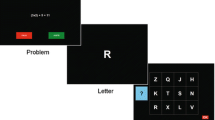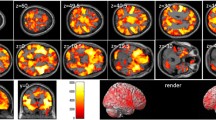Abstract
Background and aims
The simple verbal analogies test (SVAT) is a short neuropsychological task requiring few minutes of administration that explores inductive verbal abstract thinking. It already showed a good specificity and sensitivity in discriminating normal controls from probable Alzheimer’s disease patients. Verbal working memory, semantic knowledge and memory and word-finding ability are also involved in performing analogies. The aim of this study is to provide the normative values of this test in a sample of normal controls and corrections of raw scores and equivalent scores.
Methods and results
We determined the normative values of SVAT in a sample of 424 normal controls to provide corrections of raw scores and equivalent scores.
Conclusions
SVAT is a useful test to assess executive functions, working memory and to discriminate between cognitive deterioration and normal aging.
Similar content being viewed by others
References
Gentner D (1983) Structure-mapping: a theoretical framework for analogy. Cogn Sci 7:155–170
Holyoak KJ (2005) Analogy. In: Holyoak KJ, Morrison RG Jr. The Cambridge handbook of thinking and reasoning, chap 6, Cambridge University Press, Cambridge, pp 117–142
Morsanyi K, Holyoak KJ (2010) Analogical reasoning ability in autistic and typically developing children. Dev Sci. 13:578–587
Richland LE, Morrison RG, Holyoak KJ (2006) Children’s development of analogical reasoning: insights from scene analogy problems. J Exp Child Psychol 94:249–271
Salthouse TA (2005) Effects of aging on reasoning. In: Holyoak KJ, Morrison RG (eds) The Cambridge Handbook of Thinking and Reasoning. Cambridge University Press, Cambridge
Viskontas IV, Morrison RG, Holyoak KJ, Hummel JE, Knowlton BJ (2004) Relational integration, inhibition, and analogical reasoning in older adults. Psychol Aging 19:581–591
Tarquini D, Masullo C (1981) Cognitive impairment and chronic alcohol abuse: a neuropshychological study. Drug Alcohol Depend 8:103–109
Gallassi R, Lenzi P, Stracciari A et al (1986) Neuropsychological assessment of mental deterioration: purpose of a brief battery and a probabilistic definition of “normality” and “non-normality”. Acta Psychiatr Scand 74:62–67
Gallassi R, Morreale A, Di Sarro R, Lorusso S (2002) Value of clinical data and neuropsychological measures in probable Alzheimer’s disease. Arch Gerontol Geriatr 34:123–134
Carlesimo GA, Caltagirone C, Gainotti G (1996) The Mental Deterioration Battery: normative data, diagnostic reliability and qualitative analyses of cognitive impairment. The Group for the Standardization of the Mental Deterioration Battery. Eur Neurol 36:378–384
McKhann GM, Knopman DS, Chertkow H, Hyman BT et al (2011) The diagnosis of dementia due to Alzheimer’s disease: recommendations from the National Institute on Aging-Alzheimer’s Association workgroups on diagnostic guidelines for Alzheimer’s disease. Alzheimers Dement 7(3):263–269
Measso G, Cavarzeran F, Zappala G et al (1993) The mini-mental-state-examination—normative study of an Italian random sample. Dev Neuropsychol 9:77–85
Gallassi R, Bisulli A, Oppi F, Poda R, Di Felice C (2008) Subjective cognitive complaints, neuropsychological performance, affective and behavioural symptoms in non-demented patients. Int J Geriatr Psychiatry 23(1):95–101
Sommerville PN (1958) Tables for obtaining non parametric tolerance limits. Ann Math Stat 29:559–601
Halford GS (1993) Children’s understanding: the development of mental models. Lawrence Erlbaum, Hillsdale
Waltz JA, Lau A, Grewal SK, Holyoak KJ (2000) The role of working memory in analogical mapping. Mem Cogn 28:1205–1212
Cho S, Moody TD, Fernandino L et al (2010) Common and dissociable prefrontal loci associated with component mechanisms of analogical reasoning. Cereb Cortex 20:524–533
Knowlton BJ, Holyoak KJ (2009) Prefrontal substrate of human relational reasoning. In: Gazzaniga MS The cognitive neurosciences IV. MIT press, Cambridge
Robin N, Holyoak KJ (1995) Relational complexity and the functions of prefrontal cortex. In: Gazzaniga MS The cognitive neurosciences. MIT press Cambridge, pp 987–997
Raz N (2000) Aging of the brain and its impact on cognitive performance: Integration of structural and functional findings. In: Craik FIM, Salthouse TA The handbook of aging and cognition. Erlbaum, Mahwah, pp 1–90
Bunge SA, Wendelken C, Badre D, Wagner AD (2005) Analogical reasoning and prefrontal cortex: evidence for separable retrieval and integration mechanisms. Cereb Cortex 15:239–249
Green AE, Fugelsang JA, Kraemer DJ, Shamosh NA, Dunbar KN (2006) Frontopolar cortex mediates abstract integration in analogy. Brain Res 1096:125–137
Wendelken C, Nakhabenko D, Donohue SE, Carter CS, Bunge SA (2008) “Brain is to thought as stomach is to ??”: investigating the role of rostrolateral prefrontal cortex in relational reasoning. J Cogn Neurosci. 20:682–693
Wechsler D (1997) WAIS-R. Scala d’Intelligenza Wechsler per Adulti-Riveduta. Tr. it. O.S. Organizzazioni Speciali, Firenze, Italia
Spinnler H, Tognoni G (1987) Standardizzazione e taratura italiana di test neuropsicologici. Ital J Neurol Sci 6:1–120
Raven JC (1938) Progressive matrices: a perceptual test of intelligence. H.K. Lewis, London
Christoff K, Prabhakaran V, Dorfman J et al (2001) Rostrolateral prefrontal cortex involvement in relational integration during reasoning. Neuroimage 14:1136–1149
Kroger JK, Sabb FW, Fales CL, Bookheimer SY, Cohen MS, Holyoak KJ (2002) Recruitment of anterior dorsolateral prefrontal cortex in human reasoning: a parametric study of relational complexity. Cereb Cortex 12:477–485
Acknowledgments
We thank Gino Galletti Foundation for its independent research grant.
Conflict of interest
None.
Author information
Authors and Affiliations
Corresponding author
Appendices
Appendix: Simple Verbal Analogies Test
Examples
-
1.
pecora : agnello = mucca : vitello
-
2.
volante : automobile = manubrio : bicicletta
Test
-
1.
cane : cuccia = uccello : nido (gabbia)
-
2.
rete : pesca = fucile : caccia
-
3.
cacciavite: vite = martello : chiodo
-
4.
piede : scarpa = mano : guanto
-
5.
quadro : pittore = statua : scultore
-
6.
Parigi : Francia = Roma : Italia
-
7.
donna : bambino = gallina : pulcino
-
8.
smalto : unghie = rossetto : labbra
-
9.
sigarette : tabaccaio = carne : macellaio
-
10.
corda : chitarra = tastiera : pianoforte (fisarmonica o altro strumento con tastiera)
-
11.
laccio : scarpa = cintura : calzoni (gonna)
-
12.
garage : automobile = porto : nave (motoscafo, barca o imbarcazione)
-
13.
libro : carta = tavolo : legno
-
14.
coperta : letto = tovaglia : tavolo
-
15.
pistola : pallottola = arco : freccia
-
16.
avvocato : tribunale = medico : ospedale (clinica, non ambulatorio)
-
17.
treno : binario = macchina : strada (autostrada)
-
18.
marmellata : frutta = formaggio : latte
-
19.
termosifone : nafta = camino: legna
-
20.
pesce : sommergibile = uccello : aereo (dirigibile)
This English translation of SVAT
Examples
-
1.
the sheep : lamb = the cow : the calf
-
2.
the steering wheel : the car = handlebars : the bicycle
Test
-
1.
the dog : the kennel = the bird : the nest (the cage)
-
2.
the network : the fishing = the rifle : the hunting
-
3.
the screwdriver : the screw = the hammer : the nail
-
4.
the foot : the shoe = the hand : the glove
-
5.
the picture : the painter = the statue : sculptor
-
6.
Paris : France = Rome : Italy
-
7.
the woman : the child = the hen : the chick
-
8.
the enamel : nails = the lipstick : lips
-
9.
cigarettes : the tobacconist = the meat : the butcher
-
10.
the rope : the guitar = the keyboard : the piano (or other instrument with keyboard)
-
11.
the snare: the shoe = the belt : pants (skirt)
-
12.
the garage : the car = the port : the ship (boat)
-
13.
the book : the paper = the table : the wood
-
14.
the blanket : the bed = the cloth : the table
-
15.
the gun : the bullet = the arc : the arrow
-
16.
the lawyer : the court = the doctor : the hospital
-
17.
the train : the binary = the car : the road (motorway)
-
18.
the jam : fruit = the cheese : the milk
-
19.
the radiator : the oil = the fireplace : the wood
-
20.
the fish : the submarine = the bird : the plane (airship)
Rights and permissions
About this article
Cite this article
Gallassi, R., Sambati, L., Stanzani Maserati, M. et al. Simple verbal analogies test: normative data on a short task exploring abstract thinking. Aging Clin Exp Res 26, 67–71 (2014). https://doi.org/10.1007/s40520-013-0180-0
Received:
Accepted:
Published:
Issue Date:
DOI: https://doi.org/10.1007/s40520-013-0180-0




